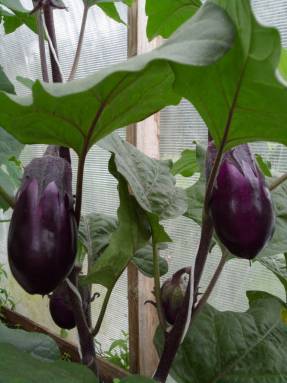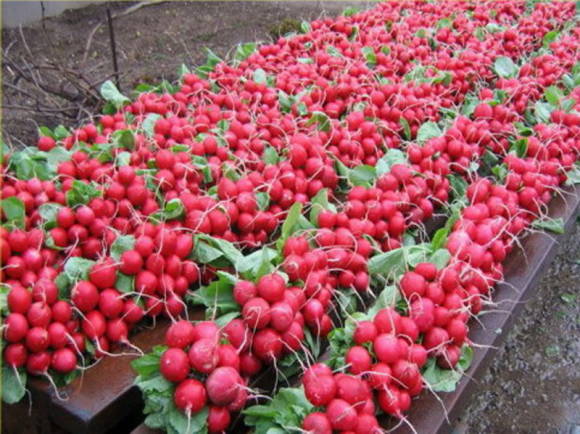 |
Over the past decade, domestic breeders have bred a huge number of wonderful varieties and hybrids of eggplant, which work well even in ordinary unheated greenhouses. Moreover, for a different "taste and color" in the truest sense of the word. For beginners - unpretentious small-fruited varieties and hybrids. And for discerning experienced gardeners - "representative" and tall specimens with beautiful heavy fruits of various shapes and colors, which are truly an adornment of any greenhouse.
I have been growing vegetables in my greenhouse for many years, including eggplant. In previous years, bacterial plant diseases have become widespread. Of the nightshade crops, eggplant is the most affected. The most offensive thing is that the "outbreak" of the disease coincides with the height of their fruiting. Of course, with good agricultural technology and care, it is possible to bring some of the plants almost to the end of the growing season, but still the yield losses are great. And often this whole idea does not make sense.
After suffering this for several years, I tried to plant eggplants on a tomato. With the same agricultural techniques and preventive measures, the result is much better. Plants are much less affected by the disease. Even with such difficult weather conditions as this season (2013), not a single plant died. For several years of experiments on late blight on the rootstock, I have not observed it even once.
Tomato is a more cold-resistant crop compared to eggplant. Having such a "cold-resistant" stock, the plants withstand unfavorable weather better and bear fruit no worse, and sometimes much better than non-grafted plants.
For grafting, it is important that the thickness of the stems of the scion (eggplant) and rootstock (tomato) coincides in thickness. Or the stock may be slightly thicker. I vaccinate when the first pair of true leaves has just begun to appear in the eggplant. Grafting at a later date is poor, the plants take longer to recover or die altogether. With earlier grafting, the plants are still too "tender", which also affects the final result. Seedlings of tomato and eggplant at the same age from the moment of germination have an unequal thickness of the stalks under the cotyledons. Tomatoes have thinner stems, so I sow them 4-6 days earlier. By the time of grafting, tomatoes already have the first pair of leaves. How many days to sow earlier, I select experimentally, it depends on the characteristics of the variety or hybrid of the rootstock itself and the quality of the seeds. Due to the insidiousness of bacteriosis, for safety reasons, I must treat the seeds with a mixture of Alirin-B with Gamair (1 tablet per 1 liter of water) for 10-12 hours at room temperature. It is very important that the seeds sprout together, therefore, before sowing, I soak them for a day in "Humate". If the seeds do not germinate very well, then for a few hours at Epin. A couple of days before sowing, I fill the bowls with soil and water with a mixture of Alirina-B and Gamair, 1 tablet per 5 liters of water. Before planting the finished seedlings in the ground, I water the ridges with the same mixture three days before planting (the soil of the ridge should be wet to the full depth, it is useless to water on dry soil). How to choose the best quality commercial soil or prepare it yourself, you can find out in the articles Sow me with love and Soils and substrates for growing seedlings. A couple of days before vaccination, the selected tomato seedlings dive into 8-10 cm plastic pots. You can also graft immediately on the day of the pick, but the stock will take longer to take root (picking + removing the upper part of the plant). Also, after placing the grafted plants under plastic bags in freshly poured soil, the roots of the rootstock can rot. To fix the rootstock with a scion, I cut strips of foil 1.5 cm wide and 3 cm long (I fold it in half around the tomato stem and gently shape it with a fingernail in the form of a tube, then insert the eggplant stalk, trying to match the slices as closely as possible). The procedure for forming a foil around the stem of the next rootstock is carried out until the crown of the plant is removed. Then, with a sharp blade at a right angle, I cut off the upper part of the plant (under the cotyledons) at the rootstock, leaving a stem at least 4-5 cm long, and move the foil up by half its width. Then, with a razor, I also cut off the scion under the cotyledons at a right angle (leaving the longest stem at least 2 cm under the crown) and insert it into the foil hole. I immediately put a plastic bag on the pot and fix it with narrow tape. And so on, until I have grafted all the plants. I do not remove the plastic bags put on the pots for 10 days (after 4 days from the moment of inoculation, I carefully make holes at the top of the bags for ventilation with a diameter of about 1 cm in the amount of 3-4 pieces). After 8 days from the moment of inoculation, using small scissors, I increase the ventilation holes to a diameter of 2.5-3 cm to adapt the plants to the surrounding air. After a couple of days, I take off the bags altogether. Then carefully remove the foil. After 10-12 days, the seedlings are already completely fused, but they can still be broken off with an awkward movement. After 20 days, the plants grow together firmly. In the future, I carry out care, processing and feeding as usual when growing eggplant seedlings. I put the pots with newly grafted plants on the windowsill, where I maintain the temperature within 22-23 ° C, avoiding the plants getting into the sun. At first, grafted plants develop more slowly than ordinary ones. This is especially noticeable in the first month. As soon as the plants develop 4 true leaves, I transfer them into 15 cm pots.When transferring, as well as when planting plants in a permanent place, it is necessary to ensure that the grafting site does not come into contact with the soil, and is higher than it. When adventitious roots form on the scion, they must be removed immediately, preventing their penetration into the soil. After the seedlings reach 40 days of age, there is a feeling that the plants are trying to "catch up". And by the time of disembarkation, they are no different from ordinary seedlings. To determine the sowing time, it is important to take into account that the plants spend about 7-8 days for the grafting to grow together. Therefore, it is necessary to sow a week earlier than usual. In my greenhouse, I grow tall, large-fruited eggplants. I like the "Sperm whale" variety the most, for several years it has never let me down with the harvest. The only condition is that it must be formed on time and correctly. In the vaccine, he also showed himself in the best possible way. You can read more about the formation and joint cultivation of eggplant with other vegetable crops in an unheated greenhouse in the articles: Greenhouse Vegetable Crops and Greenhouse Vegetable Compatibility. In a grafted eggplant, in contrast to a non-grafted one, the internodes are slightly longer, because of this they grow a little faster than ordinary eggplants (they grow up to 2.5 m per season). As a rootstock, I tested various varieties and hybrids of tomatoes: determinant, indeterminate, as well as with different shapes of leaves and fruits. In the end, I didn't see much difference. The only prerequisite should be that the variety or hybrid has a powerful root system and resistance to the main types of diseases and pests. It is important not to deepen the plant when planting ready-made seedlings in a permanent place. During the season, the stock is constantly overgrown with new adventitious roots. It's not scary, you shouldn't mulch them. These roots are formed exactly where they are comfortable, then they will not be. And if you sprinkle them with soil or some kind of mulching material, then there is a stone's throw to the scion and the grafting will lose all meaning.Disease resistance will be reduced. The grafted eggplants suffered from bacteriosis in isolated cases and in a milder form. Sometimes it was necessary to cut 1-2 shoots instead of removing the entire plant (as was the case with unvaccinated specimens). Even when the tomatoes in the greenhouse were affected by late blight, the tomato stock in the eggplant remained healthy. Photo by the author


Stock and scion preparation
Vaccination technique
























